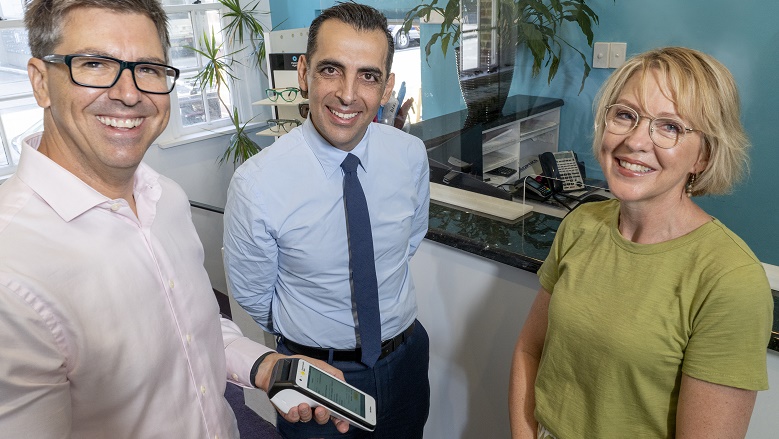Digital solutions could significantly improve efficiencies in the end-to-end delivery of Australia’s healthcare, according to a new report from CommBank Health and KPMG.
The Healthy Options report reveals that while 83 per cent of Australians are satisfied with the availability of quality healthcare, most believe digital-enabled solutions could improve patient experiences while saving providers time and money in administration.
The vast majority, almost 250,000 or 82 per cent of healthcare providers, recognise the significant opportunities digitisation and automation present – especially in primary healthcare and referred medical services.
Meanwhile around 71 per cent of consumers agree that fully digital processes would make it easier and faster to book, claim and pay for appointments. Around 44 per cent of consumers said they would consider changing providers if it offered a quicker and easier claims process.
CommBank Health Chief Executive Officer Albert Naffah said the administrative challenges to healthcare delivery might seem moderate in isolation, but together were creating a significant drag on the efficacy of the health system.
More health providers are turning to digital solutions to improve practice management, but this is limited to online bookings and moderate take up of telehealth solutions, Mr Naffah said.
“When we consider spending on primary healthcare and referred medical services in 2019-20 was $87.1 billion, even a modest administrative efficiency improvement could result in billion-dollar savings,” Mr Naffah said.
“Simplifying and speeding up payments and claims could significantly reduce cost pressures while giving patients greater control and visibility over their health data and processes.
“This is why CommBank recently launched Smart Health – a real-time solution that, among other benefits, provides a digital search, book, pay and claim option for private health insurers whilst facilitating same-day settlements.”
Factors including gaps in consumers’ knowledge of Medicare and private health insurance coverage are leading to high incidences of “bill shock”, while fragmented booking, payment and claiming systems are resulting in missed appointments and higher administrative overheads.
Less than half consumers knew how much of the cost would be covered by Medicare or private health insurance prior to their last health visit, while around 42 per cent experienced bill shock and in some cases claim denial.
KPMG Financial Services Partner Hessel Verbeek said digital solutions could help healthcare providers slash the amount of time and labour wasted on mundane administrative processes.
Around 60 per cent of consumers who sought around 300 million general practitioner, allied health and dental services were required to provide health details at both check-in and check-out at their health provider.
“Many consumers forget to bring their Medicare or private health insurance cards when claiming for healthcare services, which in 13 per cent of visits results in an inability to process claims on the spot,” Mr Verbeek said.
“In addition, patient no-shows are leading to lost productivity with around 25 per cent of consumers stating they have forgotten to attend one or more appointments in the past.
“This could be dramatically reduced by using booking system functions such as automated appointment reminders.
“The case for digitally optimising parts of the healthcare system is compelling and this report outlines the pathways to achieving it.”
To address inefficiencies and improve the healthcare experience, the Healthy Options report advocates several digital solutions to reduce administration costs and time for providers, and streamline the end-to-end patient journey and improve consumer experiences. The digital solutions include:
- The digitisation and automation of bookings and administration to reduce manual processing of claims and payments, eliminate manual booking processes and maximise the use of existing digital platforms.
- Orchestrate an integrated consumer journey to overcome the fragmented nature of the current system and fill knowledge gaps. Proactively using data and analytics, with appropriate consent, can improve health outcomes and encourage greater and more timely use of healthcare providers’ services.
- Using contemporary technology to avoid legacy limitations, including integrating existing booking, claiming and payments processes into a single system. This can enable more seamless consumer experiences while reducing providers' booking, administration and record-keeping overheads.
About the Healthy Options Report
The Healthy Options Report, produced by KPMG in partnership with CommBank Health, explores the current end-to-end delivery of healthcare in Australia from the perspective of consumers and healthcare providers. The inefficiencies and opportunities to improve healthcare delivery in Australia identified within the report are drawn from primary research conducted with consumers and providers of healthcare. This principally included a survey of 1,108 Australian household decision-makers who have experienced end-to-end healthcare delivery in the past 12 months and made a private health insurance claim and 150 health care providers across Australia, including GPs, dentists, specialists, and allied health providers.
Disclaimer:
Things you should know: The report is published solely for information purposes and is not to be construed as advice or recommendations. This report has been prepared without taking account of the objectives, financial situation and capacity to bear loss, knowledge, experience or needs of any specific person who may receive this report. All recipients, before acting on the information in this report, should consider the appropriateness and suitability of the information, having regard to their own objectives, financial situation and needs, and, if necessary seek the appropriate professional or financial advice regarding the content of this report. The Bank believes that the information in this report is correct and any opinions, conclusions or recommendations are reasonably held or made, based on the information available at the time of its compilation, but no representation or warranty, either expressed or implied, is made or provided as to accuracy, reliability or completeness of any statement made in this report. Any opinions, conclusions or recommendations set forth in this report are subject to change without notice. The Bank is under no obligation to, and does not, update or keep current the information contained in this report. Any projections and forecasts contained in this report are based on a number of assumptions and estimates and are subject to contingencies and uncertainties. Different assumptions and estimates could result in materially different results. All analysis and views of future market conditions are solely those of Commonwealth Bank. The Commonwealth Bank does not accept any liability for loss or damage arising out of the use of all or any part of the Report. Commonwealth Bank of Australia ABN 48 123 123 124 AFSL and Australian Credit Licence 234945 Privacy Policy.




